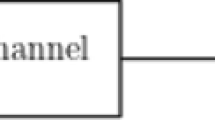Abstract
Very recently, an operator channel was defined by Koetter and Kschischang when they studied random network coding. They also introduced constant dimension codes and demonstrated that these codes can be employed to correct errors and/or erasures over the operator channel. Constant dimension codes are equivalent to the so-called linear authentication codes introduced by Wang, Xing and Safavi-Naini when constructing distributed authentication systems in 2003. In this paper, we study constant dimension codes. It is shown that Steiner structures are optimal constant dimension codes achieving the Wang-Xing-Safavi-Naini bound. Furthermore, we show that constant dimension codes achieve the Wang-Xing-Safavi-Naini bound if and only if they are certain Steiner structures. Then, we derive two Johnson type upper bounds, say I and II, on constant dimension codes. The Johnson type bound II slightly improves on the Wang-Xing-Safavi-Naini bound. Finally, we point out that a family of known Steiner structures is actually a family of optimal constant dimension codes achieving both the Johnson type bounds I and II.
Similar content being viewed by others
References
Koetter R., Kschischang F.: Coding for errors and erasures in random network coding. In: Proceedings of the IEEE International Symposium on Information Theory, pp. 791–795. Nice, France. Full version is available online at http://www.arxiv.org/abs/cs.IT/0703061 (2007).
MacWilliams F.J., Sloane N.J.A.: The Theory of Error-Correcting Codes. North-Holland, Amsterdam (1981).
Ho T., Koetter R., Médard M., Karger D., Effros M.: The benefits of coding over routing in a randomized setting. In: Proceedings of the IEEE International Symposium on Information Theory, p. 442. Yokohama, Japan (2003).
Ho T., Médard M., Koetter R., Karger D., Effros M., Shi J., Leong B.: A random linear network coding approach to multicast. IEEE Trans. Inform. Theory 52, 4413–4430 (2006)
Schwartz M., Etzion T.: Codes and anticodes in the Grassmann graph. J. Comb. Theory Ser A 97, 27–42 (2002)
Etzion T.: Perfect byte-correcting codes. IEEE Trans. Inform. Theory 44, 3140–3146 (1998)
Wang H., Xing C., Safavi-Naini R.: Linear authentication codes: bounds and constructions. IEEE Trans. Inform. Theory 49, 866–872 (2003)
Tonchev V.D.: Codes and designs. In: Pless V.C., Huffman W.C. (eds.) Handbook of Coding Theory, Chapter 15. North-Holland, Amsterdam (1998).
Author information
Authors and Affiliations
Corresponding author
Additional information
Communicated by P. Charpin.
Rights and permissions
About this article
Cite this article
Xia, ST., Fu, FW. Johnson type bounds on constant dimension codes. Des. Codes Cryptogr. 50, 163–172 (2009). https://doi.org/10.1007/s10623-008-9221-7
Received:
Revised:
Accepted:
Published:
Issue Date:
DOI: https://doi.org/10.1007/s10623-008-9221-7
Keywords
- Constant dimension codes
- Linear authentication codes
- Binary constant weight codes
- Johnson bounds
- Steiner structures
- Random network coding



